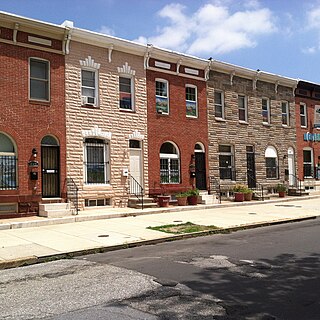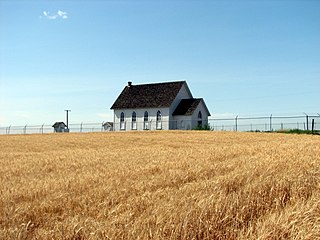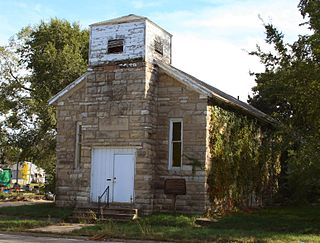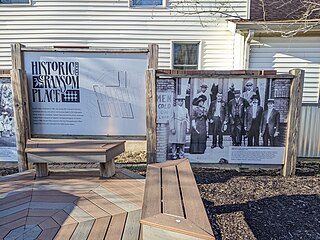
Wahkiakum County is a county located in the U.S. state of Washington. As of the 2020 census, the population was 4,422, making it the third-least populous county in Washington. The county seat and only incorporated town is Cathlamet. The county was formed out of Cowlitz County in April 1854 and is named for Chief Wahkiakum of the Chinook, who is buried in the Pioneer Cemetery in Cathlamet.

Follen Church is a historic Unitarian Universalist congregation located at 755 Massachusetts Avenue in Lexington, Massachusetts, United States.

LDS Moapa Stake Office Building, also known as the Virmoa Maternity Hospital, is listed on the National Register of Historic Places in Overton, Nevada. It was built between 1917 and 1919 to serve the community of Moapa Valley as a local office, classroom and records repository for the LDS Church. In 1939, the local stake decided to relocate their offices to Las Vegas as travel between the communities became easier. The building then sat vacant.

Oaks Pioneer Church, formerly known as St. John's Episcopal Church, in southeast Portland in the U.S. state of Oregon is a non-denominational one-story chapel listed on the National Register of Historic Places. Built in 1851, it was added to the register in 1974. It is the oldest intact church building in Oregon.

Bethel AME Church is a historic African Methodist Episcopal church at 220 Bell Street in Reno, Nevada. It has served as a hub for Reno's African American community since it was built in 1910 for early black settlers. In addition to its role as a religious and community center, it functioned as a resource center for black divorce seekers who faced difficulties in a segregated city during the middle decades of the twentieth century. In the 1960s, during the American civil rights movement, the church provided a meeting place for the local chapter of the National Association for the Advancement of Colored People (NAACP) and other civil rights activists.

The Parowan Meetinghouse, sometimes referred to as the Parowan Tabernacle or the Parowan Old Rock Church is a historic meetinghouse of the Church of Jesus Christ of Latter-day Saints in Parowan, Utah, United States, that is listed on the National Register of Historic Places (NRHP).

East Monument Historic District or Little Bohemia, is a national historic district in Baltimore, Maryland. It is a large residential area with a commercial strip along East Monument Street. It comprises approximately 88 whole and partial blocks. The residential area is composed primarily of rowhouses that were developed, beginning in the 1870s, as housing for Baltimore's growing Bohemian (Czech) immigrant community. During the late 19th and early 20th centuries the neighborhood was the heart of the Bohemian community in Baltimore. The Bohemian National Parish of the Roman Catholic Church, St. Wenceslaus, is located in the neighborhood. The historic district includes all of McElderry Park and Milton-Montford, most of Middle East and Madison-Eastend, and parts of Ellwood Park.

The Kinnickinnic Church is a historic church in Kinnickinnic, Wisconsin, United States. The Greek Revival church was constructed for $2,000 in 1868 and was originally shared by a Methodist and a Congregationalist congregation. In 1895, the Congregationalists purchased the church for $300; it maintained a congregation there until 1951. In 1962, the Kinnickinnic Historical Association bought the vacant church to prevent it from being converted to a home. The church, which contains a historic pump organ, is currently used for social events in the community. On October 6, 2000, the church was added to the National Register of Historic Places.

Greasewood Finnish Apostolic Lutheran Church is a historic pioneer church located 5 miles west of Adams, Oregon. It was built by volunteers on donated land in 1884 to serve the immigrant Finnish Laestadian community. Services were held in Finnish both for the immigrants and their children, whose mother tongue was also Finnish. After breakups within the Laestadian community, this church affiliated with the Apostolic Lutheran Church of America. Due to the remote location, preachers from surrounding areas as well as the American Midwest, and even as far away as Finland, were brought in to speak.

St. John Baptist Church is an African American Baptist congregation that started in 1919 and is the name of its historic church building at 715 6th Street SW in Mason City, Iowa that was built in 1937.

Baptist Church, also known as Stone Church, is a historic church building in Sperry, Iowa, United States. The Baptist congregation that built this church was founded in 1840. They built this building seven years later. In addition to religious services, it was the meeting place for a variety of community events. The church building is surrounded by a cemetery, which contains the graves of some of the areas first settlers. The utilitarian design of the church building and the use of local materials is characteristic of pioneer church architecture in Iowa. The 48-by-36-foot building is a single-story, gable roof structure. It features a cornice return. The roughly cut stone exterior uses larger stones at the corners for a decorative effect. The interior walls are plaster and the flooring are pine boards. It still houses the original hardwood pews, pulpit, minister's settee, and hand-carved altar. The building was damaged in a tornado in 1964, and the repairs conform to the original character of the church. It was added to the National Register in 1977.

Graysontown is an unincorporated community in Montgomery County, Virginia, United States. Graysontown is located on the Little River 6.5 miles (10.5 km) south of Radford.

St. Andrew's Church is an historic Episcopal church complex in Richmond, Virginia, United States. The complex consists of the church (1901), school (1901), parish hall (1904), Instructive Nurse Association Building (1904), and William Byrd Community House or Arents Free Library (1908). The church is a rough-faced Virginia granite, cruciform Gothic Revival style structure dominated by a 115-foot corner tower. The school and parish hall are three-story, brick buildings on a stone basements.

The Stockton Street Historic District covers both sides of Stockton Street, from Railroad Avenue to Summit Street, and a portion of Rogers Avenue in Hightstown, New Jersey. It is notable for its Victorian homes, First Methodist Church, and the Hightstown Civil War monument. It is also significant for its association with the introduction of rail service to New Jersey, as the first railroad in the United States to connect two major cities, New York and Philadelphia, originally ran along what is now Railroad Avenue at the eastern end of the district. In 1832, the John Bull, the first locomotive in the country, provided the first steam-powered passenger rail service in the country, stopping at Stockton Street. In July 2015, Hightstown became a Preserve America community which enhances historic preservation, including the district.

Lincoln Pioneer Village is a memorial along the Ohio River in Rockport, Spencer County, Indiana to President Abraham Lincoln who lived in the county during his boyhood years. It was built in 1934 and 1935 in the city park by the Works Progress Administration. George Honig, an artist and sculptor from Spencer County, designed the memorial. He also oversaw the building of the pioneer village replica, which was sponsored by the Spencer County Historical Society and the Rockport City Council. It was listed as a historic district on the National Register of Historic Places on April 20, 1998.

Ransom Place Historic District is a national historic district in Indianapolis, Indiana, United States. The district consists mainly of a six-square block in a historically Black residential section of Indianapolis, located just one block from Indiana Avenue. It was originally developed during the 1880s and 1890s, coinciding with the growth of Indiana Avenue as the central commercial district for Indianapolis's Black population at that time. It was listed on the National Register of Historic Places in 1992.

The Old Settlers' Association of Johnson County Cabins, also known as City Park Cabins, are historic buildings located in Iowa City, Iowa, United States. These are two log structures built by the Old Settlers' Association of Johnson County. The single-room log cabin was built in 1889 for Johnson County's semicentennial. It had been located at two different county fairground sites until it was moved to City Park in 1918. The second cabin was built here by the association in 1913. It is a dogtrot house that is meant to be a replica of an early trading post in this area. These are typical log house forms from Iowa's pioneer era whose existence are now rare. They also represent an effort by a social organization to commemorate the community's common pioneer heritage. A third element that is part of the historical designation is a bronze plaque affixed to a granite boulder. Located southwest of the cabins, it was installed in 1929 to mark a "Grand Army Tree" that was planted nearby. It is not known if the tree survives. The buildings and plaque were listed together on the National Register of Historic Places in 2013.
Vernon Center is a hamlet in Oneida County, New York, United States. The community is located at the intersection of state routes 26 and 31, 2.7 miles (4.3 km) southeast of the village of Vernon. Vernon Center has a post office with ZIP code 13477, which opened on January 16, 1823.



















